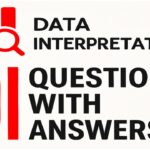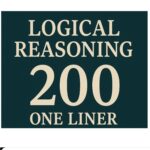Results


#1. The highest level of cognitive domain is:
Key Points
- B. S. Bloom has divided the cognitive objectives into six categories (under Bloom’s taxonomy) arranged from the lowest to the highest level of functioning.
Stages Subdomains of Cognitive Domain:
- Knowledge: It refers to the process of recognizing and recalling information.
- Comprehension: It refers to the process of interpreting and assimilating information.
- Application: It refers to the process of utilizing information in new and different situations.
- Analysis: It refers to the process of identifying the pattern and connection among the given information
- Synthesis: It refers to the process of combining information and making connections among them to generate a new idea.
- Evaluation: It refers to the process of making judgments and Justifying decisions about the value of information and materials
Hence, it could be concluded that the highest level of cognitive domain is evaluation.
#2. Which of the following is an example of higher-order of cognitive learning outcome?
#3. Which of the following is not a domain or category of instructional objectives according to Bloom?
Benjamin Bloom’s taxonomy is a set of three hierarchical models that refers to the classification of educational learning objectives.
- In the taxonomy, Bloom identified three domains of learning which include cognitive, affective, and psychomotor.
- These three domains have been divided in a way that proceeds from the simplest process to the complex.
 Key Points
Key Points
- Cognitive domains: In this domain, a child deals with knowledge and hence, learns to create, evaluate, analyze, etc.
- Psychomotor domains: It is concerned with acquiring skills that require the integration of mental and physical movements.
- Affective domains: This domain comes into play when we grow in emotional areas such as feelings, attitudes, etc. It includes how we deal with things emotionally, such as feelings, values, appreciation, enthusiasms, motivations, and attitudes.
Hence, it could be concluded that ‘Socio-Political Domain’ is not a domain or category of instructional objectives according to Bloom.
#4. The question, “How would you prove that the earth is round or not round?” is based on the ______ objective.
#5. The-correct sequence of objectives of affective domain according to Bloom’s Taxonomy is
Objectives in the affective domain concern feelings and attitudes that students are expected to develop as a result of instruction. There is no doubt that a lot of confusion prevails with regard to the statement of objectives in the affective domain, as compared to the cognitive domain. Terms like interest, appreciation, values, attitudes, etc., give varying shades of meaning.  Key Points
Key Points
- Receiving (attending and awareness): This is the first and the lowest level of the objectives under an affective domain. At this level, we are concerned with the student’s sensitivity to certain stimuli; that is, whether (s)he is willing to receive or attend to the stimuli.
- Responding (acting, feelings, movement, and change): It is the next higher level to simple awareness or attention. This category implies greater motivation and regularity in attendance.
- Valuing (worth, utility, and cause-effect relationship): This is the third level under the affective domain and implies a commitment to certain ideals or values. This objective
includes the development of attitudes. - Organization (judging, integrating, and categorizing): This level pertains to building a system of values. At this level, values are conceptualized and conflicts between the values are resolved and interrelationships are established.
- Characterization (sustained use of new values and expressions of commitment): Characterisation by a value and set of values is at the top of the affective domain. It regulates a person’s behavior through certain values, ideas, or beliefs and the integration of values and attitudes into a world view or total philosophy of life of his own.
Hence, it can be concluded that Receiving → Responding → Valuing → Organisation → Characterisation is the correct sequence of objectives of the affective domain according to Bloom’s Taxonomy.
#6. What involves control over multiple motor skills in a logical and systematic way that helps an individual to complete the desired action ?
Benjamin Bloom’s taxonomy is a set of three hierarchical models that refers to the classification of educational learning objectives. In the taxonomy, Bloom identified three domains of learning which include cognitive, affective, and conative or psychomotor. The psychomotor domain of learning is concerned with acquiring skills that require the integration of mental and physical movements.
 Key Points The psychomotor domain has five levels of motor skills that require different levels of competence in the performance of the skills. The following are the five levels:
Key Points The psychomotor domain has five levels of motor skills that require different levels of competence in the performance of the skills. The following are the five levels:
- Imitation: Modeling someone else’s behavior after their observation. Poor performance might occur. For example, copy a piece of art.
- Manipulation: The ability to carry out specific acts through practice and attention to guidelines. Example: Producing work independently after receiving instruction or reading about it.
- Precision: It involves some level of expertise used to do the task. The learner independently performs the skill with accuracy, proportion, and sameness. There are hardly many mistakes. For example: Making something better and better until it is “just right.”
- Articulation: Articulation involves control over multiple motor skills in a logical and systematic way which helps an individual to complete the desired action.
- For example, creating a video that involves music, drama, color, sound, etc.
- Naturalization: Achieving high levels of performance without having to think about them too much.
Hence, we can conclude that Articulation involves control over multiple motor skills in a logical and systematic way that helps an individual to complete the desired action.
#7. Which level of teaching uses a higher level of cognitive abilities as specified in Bloom’s taxonomy?
#8. According to bloom’s taxonomy of educational objectives, the lowest level of cognitive domain is:
 Key Points Bloom concentrated on the study of the cognitive domain. The classification of objectives is known as Bloom’s taxonomy of objectives or Taxonomy of educational objectives in 1956. The lowest level of the cognitive domain is knowledge.
Key Points Bloom concentrated on the study of the cognitive domain. The classification of objectives is known as Bloom’s taxonomy of objectives or Taxonomy of educational objectives in 1956. The lowest level of the cognitive domain is knowledge.
| Evaluation (Highest) |
|
| Synthesis |
|
| Analysis
|
|
| Application |
|
| Comprehension |
|
| Knowledge (Lowest) |
|
Hence, it becomes clear that knowledge is the lowest level of the cognitive domain.
#9. The ability to use learnt material in a new situation by the child making use of his previous knowledge to solve the problem is called ______.
#10. According to Bloom’s taxonomy which option is incorrect for the preparation of objective based questions?
Benjamin Bloom’s taxonomy is a set of three hierarchical models that refers to the classification of educational learning objectives. In the taxonomy, Bloom identified three domains of learning which include cognitive, affective, and psychomotor.
These three domains have been divided in a way that proceeds from the simplest process to the complex.
- Cognitive domains: In this domain, a child deals with knowledge and hence, learns to create, evaluate, analyze, etc.
- Psychomotor domains: It is concerned with acquiring skills that require the integration of mental and physical movements.
- Affective domains: It includes how we deal with things emotionally, such as feelings, values, appreciation, etc.
The work of preparing questions is related to the ‘cognitive domain’ which involves mental skills that are categorized into six levels of learning that serve in the development of intellectual skills and acquisition power.






















Great knowledge
Thanks ! Keep Watching
The blooms texonomy is the set of three lists congnitive..affective and psychomotor
Me v test dena but menu score pta ni lgda
Hello mam ucg net 1st paper ki pdf Kahan se download hogi
Hello Hi mam your class teaching very excellent and your study material is very useful
I need your ugc net Mattarial….hindi medium
Mam Hindi mein nhi h kya MCQ